Silk rugs. What you need to know
Silk is known as a fabric, and fiber, of luxury.
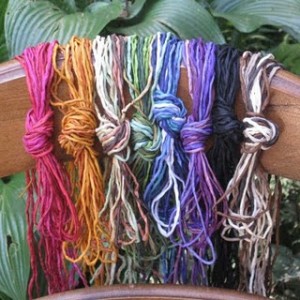
Silk Strands
People think you need to baby silk items, but silk is actually a very strong – and beautiful – fiber. (Unlike rayon and viscose, both names for artificial silk rug fibers, which are incredibly weak, yellow, lose color, and break at an alarming rate under foot traffic.)
Silk has strong tensile strength, and apparently has unique properties that beyond making fabulous looking fabrics and textiles, may become known for many other things. This short video on TED shares some of the magic of silk in other uses (this was amazing to watch):
If silk was not strong, weavers would not be able to weave these intricate designs, at a knot count that can exceed 1500 knots per square inch for the finest of weaves.
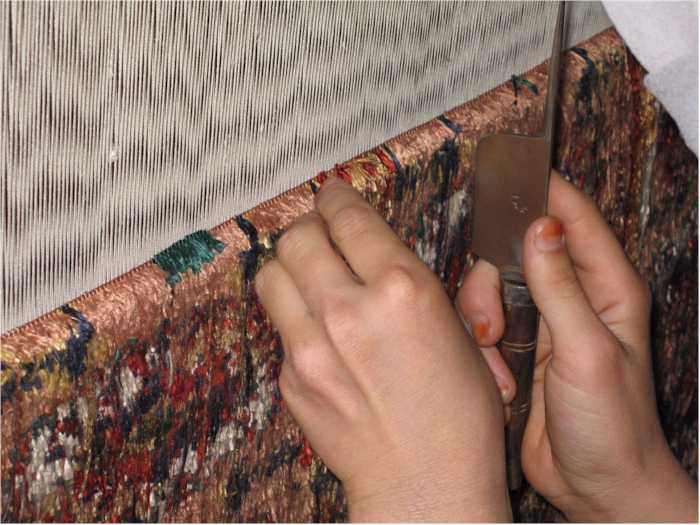
Silk rug loom. Knots tied by hand.
If it was not strong, those strands would break – which is why real silk rugs will be thinner, more pliable, and much more detailed designs than any of the “fake” knock-off’s.
Here’s a real silk Qum rug (hand woven in Persia):
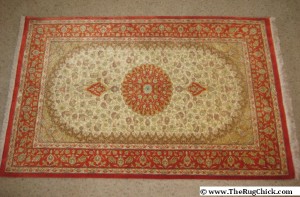
Silk Qum rug
Silk rugs are woven in many countries besides the Middle East, you see many from China, India, and Turkey as well. And their construction, as you can see is fine, thin, and very colorful:
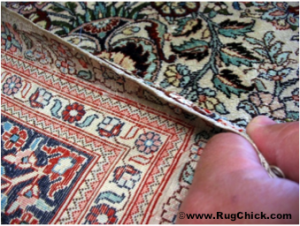
Turkish Hereke silk rug, very fine weave as seen on back side.
Compare the last photo with this rayon (viscose) rug from China, which is thicker, cruder, shaggier, and overall obviously *not* the real deal:
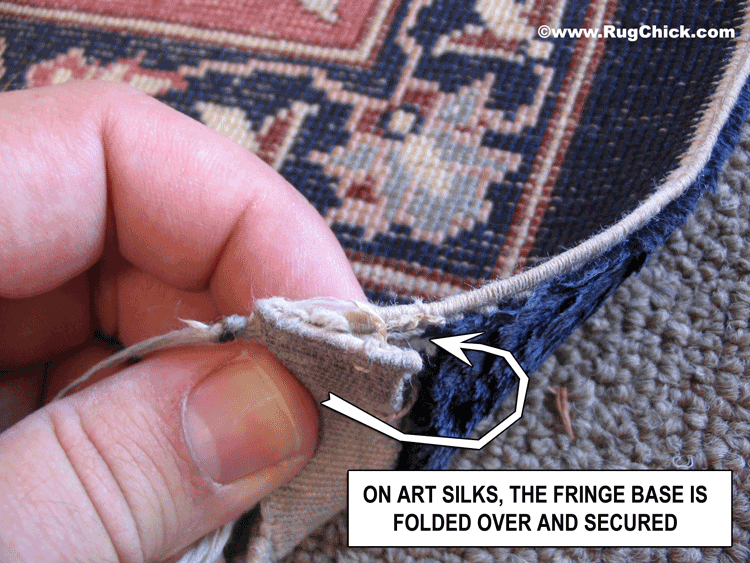
Fake silk rug (rayon) from China
Rug cleaners – especially new ones – are frightened of handling silk rugs.
And they should be.
Not because silk is not strong enough to be washed. It most certainly is. The problem is not with the fiber strength, but with the dyes…
…and the fact that silk rugs, especially finely woven ones, are VERY expensive to replace if you happen to bleed them. (And your insurance may not cover this – you have to check with your agent.)
It’s not unusual for a small silk rug to have been purchased for thousands of dollars, especially if it is a fine quality Qum or Hereke.
So if you are a rug cleaner, and have a silk rug on your hands, these are the questions you need to ask yourself:
1) Is this real silk or artificial silk?
You will not necessarily clean it differently, because due to rayon/viscose being horribly weak you have to treat that inferior fiber very gently so you may follow the same steps as with real silk. But what matters is the VALUE of the piece, and whether you are insured if a lack of experience on your part results in ruining the rug during cleaning. That is why you want to know if it is the real thing.
A rough rule of thumb, obviously with exceptions (there are ALWAYS exceptions in the rug world), the thinner the nap of the pile and the higher the knot count per square inch, the more valuable the piece. That is for silk, not for wool. Wool rugs and value are another ball game entirely.
2) Do you have experience and the facility to clean silk?
If you have a full rug cleaning facility, with a roller wringer to feed the rug through, then it is possible to quickly wash a silk rug. And that is what is needed for a silk rug, a quick overall wash process. Using the right dye stabilizing solution, keeping the cleaning solution on the acidic side, and removing the excess water as soon as humanly possible.
You have to be a MASTER at fiber and dye testing, and pre-inspection, so that you know exactly what needs to be done with the textile to clean it – or to know if you cannot clean it safely.
If you have dry cleaning capabilities, some rug plants will dry clean silk rugs.
We personally like to wash rugs. I don’t like to leave residue in fibers. I like them truly clean. And I am sensitive to dry cleaning solvents, so I’m not a fan of them. That said, we have a roller wringer that allows us to remove the moisture in under a minute to that the rug can then lay out flat to dry very quickly. If you do not have a wringer, you will not want to tackle handling any silk – or fake silk – rugs for washing. Subcontract them to a full service rug cleaning facility with experience with silk.
Another tool I have found that works extremely well for cleaning silk fabric furnishings, and silk rugs which may be too risky to fully soak in a wash due to dye migration risks, and rayon/viscose rugs that can’t take much agitation at all, is the new Upholstery Pro by Sapphire Scientific.
The advantages this tool has in regards to riskier fibers/fabrics is that it has two vacuums surrounding the moisture delivery, so it is thorough, controlled, and immediate wash and extraction:

Two vacuums and a smooth head makes no marks.
My friend and peer Jim Pemberton, who is an expert in fine fabric care, has used this tool successfully on both microfiber upholstery, rayon, and aged (i.e. fragile) upholstery with no marking, excellent cleaning, and complete control of the moisture delivery and removal.
I’ve used the tool on rugs that normally I would turn away due to the risks of proper cleaning. Real silk rugs that due to age were too fragile to put through a proper wash, as well as rayon rugs that were too crummy that even brushing them was causing fibers to break off.
It also is excellent for any spot work you need to do on a rug, where you would like to work a bit more on a specific area without keeping the entire rug under water during that extra specialty servicing.
This is absolutely a tool that every professional rug cleaner, or fine fabric specialist, needs in their facility.
That said, even the best tool in an untrained hand, will lead to a disaster. So if you are just getting into the professional rug cleaning field, plan to get your rug cleaning education through courses and real-world training on rugs that you own first. Thrift stores and garage sales offer a myriad of cheap and filthy rugs of all shapes, sizes, and qualities – so if you are serious about getting into rugs, don’t practice on rugs owned by others, that’s tempting fate. Even eBay has lots of cheap rugs to invest in to get some practice.
And while you are doing this, find a local long-time rug cleaning plant to subcontract the valuable textiles that your clients send to you. Sometimes the best (and easiest) thing to do is to put your client’s valued textiles into more experienced hands.
Now, if you are the owner of an investment silk rug reading this post, I personally feel that the last place a silk rug belongs is on the floor. Why? Again, not because it is not strong. It is.
The nature of the silk fiber, being a smooth single filament, means it does not have “pockets” to hide soil in it like wool does. This means silk rugs (and cotton and rayon as well) look soiled quicker than wool rugs when exposed to the same amount of foot traffic and dust settling on them. It’s just in the nature of the fiber.
Silk also reflects light brilliantly, and when you walk around the rug it has a very distinct bright “light” direction, and a deeper dark direction. Wool does the same thing, which I’ve written about in a wool rug post, but with silk this difference is much more stark. You can literally change the look and colors of the same rug by walking from one end to the other. (Go ahead, walk around your silk rug and see what I’m talking about.)
This means any foot traffic on a silk rug that distorts the fibers will make it reflect light differently in those spots, giving you a mix of dark and light areas that might give you the illusion it is dirty… when it’s just got “messed up” pile.
The finer silk rugs are intricate pieces of art, and many of our clients prefer to mount them on the wall as textile art, rather than having their silk rugs on the floor, and worrying about feet, paws, or spills.
We use velcro to hang silk rugs flat against the wall:
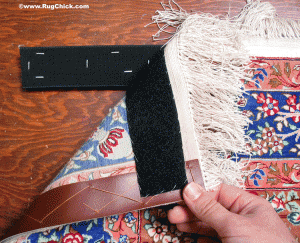
Velcro along the top of silk rug for hanging.
Here’s why rugs are generally hung with velcro => Hanging Rugs
Some of the most magnificent rugs I’ve seen in my life have been finely woven silk textiles. Hopefully these tips will help cleaners stay out of trouble when handling these pieces of textile art, and help those who own them to better showcase, and care, for them.
– Lisa
